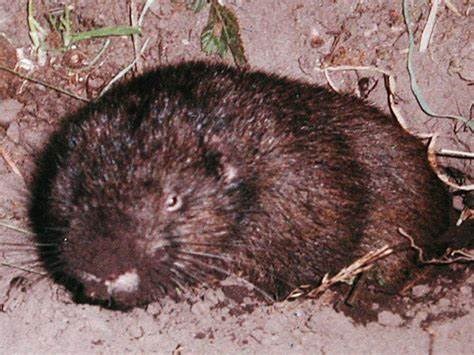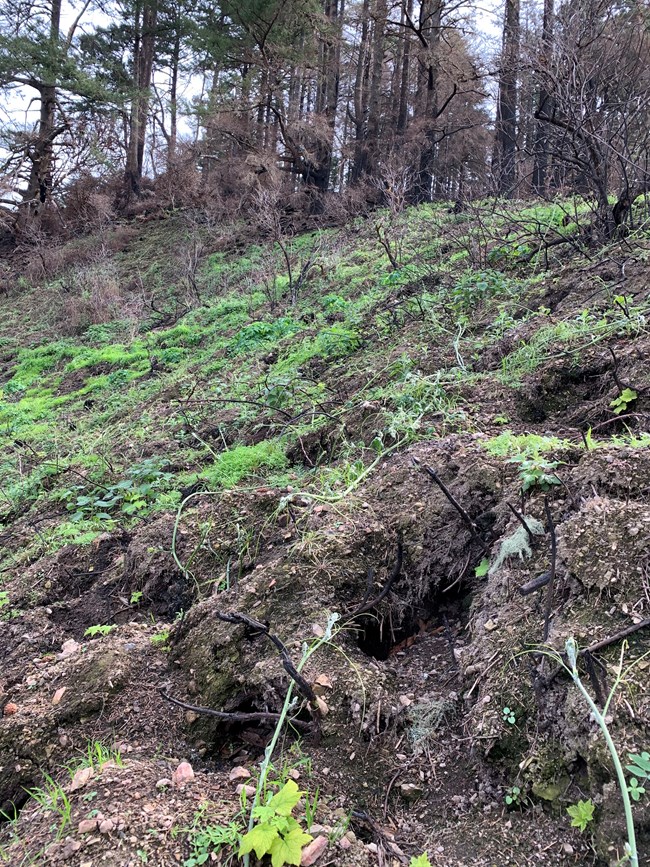Last updated: December 9, 2021
Article
Woodward Fire Kickstarts Monitoring of the Point Reyes Mountain Beaver

USGS / Gary Fellers
July 2021 - The 2020 Woodward Fire has created a unique opportunity for biologists to investigate an elusive and mysterious mammal population: Point Reyes mountain beavers (Aplodontia rufa phaea).
Mammals are notoriously hard to study, and the Point Reyes Mountain Beaver is no different. But fire has revealed some clues. In some areas, fire burned off the top layer of soil, exposing complex networks of tunnels two or three inches under the ground. Biologists are applying this "x-ray" vision of mountain beaver habitat to locate active burrows in unburned areas.
A primordial part of the Point Reyes food web
Biologists call mountain beavers "primitive rodents" because they are the last species left of the ancient family Aplodontidae, which split off from other rodents by the late Eocene. They look pretty different from gophers, rats, and other contemporary rodents. While other rodents evolved adaptations to efficiently conserve water, the moisture-rich vegetation available at Point Reyes allowed mountain beavers to persist with a simpler kidney system. As such, mountain beavers can only survive in areas near water or with extensive summer fog along the Pacific coast. The subspecies of mountain beaver found at Point Reyes is endemic to the area—found nowhere else. They have co-evolved with Point Reyes flora and fauna, acting as food for mesocarnivores like coyotes, foxes, and spotted owls, and shaping habitat by creating burrows, turning over soils, and converting the plants they eat into nutrient-rich pellets.
Mountain beavers do not travel far from their burrows, so if their habitat changes, they likely won't find a new home. With the climate changing and seeps like those found at Point Reyes becoming drier, mountain beavers are found in fewer and fewer areas. Data collected 10 years after the Point Reyes Vision Fire indicate that the mountain beaver population in the burned area had only recovered to half their previous numbers.

NPS / Matt Lau
Fire aftermath provides clues for tracking an elusive mammal
Post-Woodward fire, biologists are looking for empty burrows within the burn footprint. Unfortunately, it’s unlikely that these small animals got out of the fire alive.
Biologists hope that finding empty burrows in the burned area will help them find active burrows in the unburned area. But so far, the unburned habitat has proved extremely difficult to navigate. Mountain beavers favor vegetation cover so thick that you can barely walk through it, and biologists will have to look for burrows square foot by square foot.
Despite the challenge, seeing where burrows are in the burned areas has revealed recurring patterns in the kind of vegetation and topography around burrow sites. For example mountain beavers prefer areas with certain plant species, like sword ferns and salmon berry.
Biologists will use data from these surveys to determine how the population may have recovered after the Mt. Vision and Woodward Fires. Ultimately, they hope to create a ‘habitat suitability model’ that will help natural resources staff and park managers collaborate to avoid damaging areas that mountain beavers may be using as habitat.
For more information
- Pacific Coast Science & Learning Center Mountain Beavers webpage
- Point Reyes National Seashore Mountain Beaver webpage
- Contact Taylor Ellis or Matt Lau
